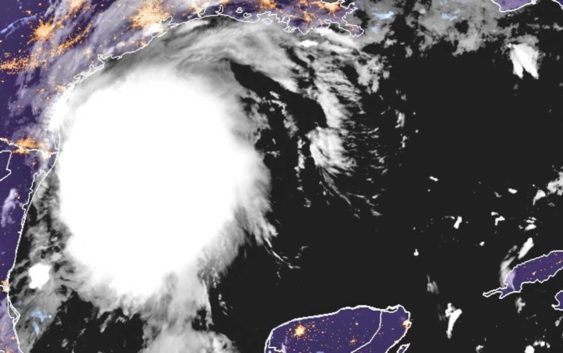- Seven months after Hurricane Helene, Chimney Rock rebuilds with resilience
- Wildfire in New Jersey Pine Barrens expected to grow before it’s contained, officials say
- Storm damage forces recovery efforts in Lancaster, Chester counties
- Evacuation orders lifted as fast-moving New Jersey wildfire burns
- Heartbreak for NC resident as wildfire reduces lifetime home to ashes
Nicholas strengthens into Category 1 hurricane, threatens Texas with heavy rain

The storm is likely to strike the same area hit by Hurricane Harvey in 2017 and storm-battered Louisiana.
Although the system is expected to generate only a fraction as much rain as Harvey, nearly all of the state’s coastline was under a tropical storm warning that included potential flash floods and urban flooding.
Texas Gov. Greg Abbott said the state has placed rescue teams and resources in the Houston area and along the Texas Gulf Coast.
Hurricane #Nicholas Advisory 8: Nicholas Becomes a Hurricane. Bringing Heavy Rains, Strong Winds, and Storm Surges to Portions Of the Central and Upper Texas Coasts. https://t.co/VqHn0u1vgc
— National Hurricane Center (@NHC_Atlantic) September 14, 2021
The system is moving north-northeast at 10 mph and has maximum sustained winds of 75 mph.
“This is a storm that could leave heavy rain, as well as wind and probably flooding, in various different regions along the Gulf Coast. We urge you to listen to local weather alerts, heed local warnings,” Abbott said in a video message.
Nicholas is headed toward the same area of Texas that was hit hard by Hurricane Harvey in 2017. That storm made landfall in the middle Texas coast then stalled for four days, dropping more than 60 inches (152 cm) of rain in parts of southeast Texas. Harvey was blamed for at least 68 deaths.
Louisiana Gov. John Bel Edwards on Sunday night declared a state of emergency ahead of the storm’s arrival in a state still recovering from Hurricane Ida and last year’s Hurricane Laura and historic flooding.
“The most severe threat to Louisiana is in the southwest portion of the state, where recovery from Hurricane Laura and the May flooding is ongoing. In this area heavy rain and flash flooding are possible. However, it is also likely that all of south Louisiana will see heavy rain this week, including areas recently affected by Hurricane Ida,” Edwards said.
The storm was expected to bring the heaviest rainfall west of where Hurricane Ida slammed into Louisiana two weeks ago. Although forecasters did not expect Louisiana to suffer from strong winds again, meteorologist Bob Henson at Yale Climate Connections predicted rainfall could still plague places where the hurricane toppled homes, paralyzed electrical and water infrastructure and left at least 26 people dead.
“There could be several inches of rain across southeast Louisiana, where Ida struck,” Henson said in an email.
Across Louisiana, just under 120,000 customers remained without power Monday morning, according to the utility tracking site poweroutage.us.
The storm is projected to move slowly up the coastland and could bring torrential rain over several days, said meteorologist Donald Jones of the National Weather Service in Lake Charles, Louisiana.
“Heavy rain, flash flooding appears to be the biggest threat across our region,” he said.
While Lake Charles received minimal impact from Ida, the city saw multiple wallops from Hurricane Laura and Hurricane Delta in 2020, a winter storm in February as well as historic flooding this spring.
“We are still a very battered city,” Lake Charles Mayor Nic Hunter said.
He said the city is taking the threat of the storm seriously, as it does all tropical systems.
“Hope and prayer is not a good game plan,” Hunter said.
In Cameron Parish in coastal Louisiana, Scott Trahan is still finishing repairs on his home damaged from last year’s Hurricane Laura that put about 2 feet of water in his house. He hopes to be finished by Christmas. He said many in his area have moved instead of rebuilding.
“If you get your butt whipped about four times, you are not going to get back up again. You are going to go somewhere else,” Trahan said.
Colorado State University hurricane researcher Phil Klotzbach said via Twitter that Nicholas is the 14th named storm of 2021 Atlantic hurricane season. Only 4 other years since 1966 have had 14 or more named storms by Sept. 12: 2005, 2011, 2012 and 2020.
___
Associated Press writer Jill Bleed in Little Rock, Arkansas, contributed to this report.
Copyright © 2021 by The Associated Press. All Rights Reserved.